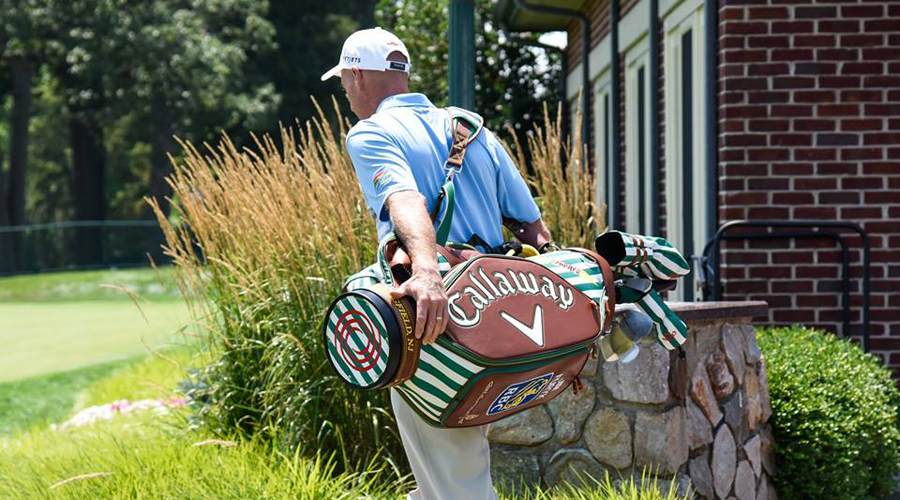By Thomas J. Ryan
Callaway Golf Co. (NYSE:ELY) wasted little time capitalizing on Nike’s exit from the golf equipment business.
On November 3, the company announced the hiring of Hideyuki “Rock” Ishii, the former senior director of golf-ball innovation at Nike, as its senior director of advanced golf ball research. At the same time, Callowat lifted its guidance for the full year after reporting that improved sales led to a lower-than-expected loss for the third quarter.
Callaway President and CEO Chip Brewer noted to analysts on a conference call that the hiring of Ishii, who spent 20 years with Nike and had made custom specification balls for Tiger Woods and Rory McIlroy, comes on top of Callaway’s other investments in the golf business. These included the formation of its new apparel joint venture in Japan, its purchase of Toulon Design, and the hiring of Sean Toulon to run its global putter business.
“At a time where other companies are either exiting the hardgoods space or being forced to cut back on investments, we believe our ability and commitment to reinvest will differentiate us and deliver profitable growth in the future when market conditions inevitably improve,” said Brewer. “I believe history is full of examples that show that those that invest during difficult times are often the ones that do the best in the long run.”
Overall, Brewer said the company continues to benefit from strategic initiatives undertaken during the last three years, including working capital improvements and the extension of product life cycles, marked by gross margins improving 110 basis points year to date.
In the third quarter, while Callaway’s net loss widened to $5.9 million, or 6 cents a share (from $3.6 million, or 4 cents, a year ago), the results were better than it had forecasted. It had expected a net loss between 10 cents and 15 cents as a result of a planned increase in operating expenses for the period, which is also typically weak because of the seasonality of the business.
Sales for the third quarter, however, increased 6.9 percent to $187.9 million, above plan, to help offset the increased expenses. The sales gains reflected the company’s continued brand strength and additional hardgoods market share gains, as well as the commencement of the company’s joint venture in Japan in the quarter.
In the U.S., revenues in the quarter grew 6.9 percent to $92.9 million, despite soft market conditions, including the bankruptcy of Golfsmith.
“This performance was driven by excellent market share performance,” said Brewer. Year-to-date hardgoods market share in the U.S. through Q3 was 22.7 percent, up 140 basis points year over year, marked by growth in both green grass distribution and custom product. Clubs netted a 25.7 percent share year to date, up 120 basis points, and golf ball scored a 13.7 percent year-to-date share, up 220 basis points.
In other regions, sales in Japan were up 23 percent to $41.4 million while gaining 2.9 percent on a currency-neutral basis. The initial gains from the Japan apparel joint venture were offset by a 20-percent decline in its core golf equipment business, reflecting both fewer new product launches year over year and soft market conditions. Japan remains “roughly on track” to its revenue plan for the full year, with a “meaningful” improvement expected in earnings, Brewer said.
Europe was down 1.3 percent to $26.3 million but grew 6.1 percent on a currency-neutral basis, benefiting from market share gains. In the rest of Asia, sales were down 5.7 percent to $15.9 million and off 8.7 percent on a currency-neutral basis. In other foreign countries, sales were down 2.7 percent to $11.3 million and slid 5 percent on a currency-neutral basis.
By category, Callaway’s golf ball business jumped 11.6 percent during the quarter. Its irons and wedge business grew 18.4 percent, led by its Steelhead launch.
Gross margins in the quarter eroded 210 basis points to 42 percent. A shift in product launch timing and compensation in support of new product launches in Japan and the U.S was only partially offset by higher average selling prices and higher golf ball margins in the third quarter of 2016. Operating expense expanded 9.5 percent to $84.1 million, primarily to cover the startup of the Japan apparel joint venture, some incremental bad debt expense associated with the Golfsmith bankruptcy and the timing of marketing expenses. Operating expense as a percent of revenue was 44.8 percent in the third quarter of 2016, compared to 43.7 percent in the prior year.
Looking ahead, the company now expects sales for 2016 in the range of $870 million to $880 million, up from $855 million to $880 million previously. Sales were $844 million in 2015. Callaway’s projection for EPS was raised to a range of 50 cents to 54 cents from a previous range of 40 cents to 50 cents. It earned 17 cents in 2015.
Asked in a Q&A session to access the implication of Nike’s exit from hardgoods, Brewer said it’s “difficult to quantify what that is and we’re really not going to try in the face of so many other factors, very dynamic marketplace right now.” He did note, however, that the Nike golf equipment business does not have significant share or volume in golf clubs and golf balls, and much of Nike’s equipment product wasn’t in the premium category. Nike will continue to make golf apparel and footwear.
But Brewer generally viewed Nike’s exit as a “positive.” Beyond opportunities to grab Nike’s equipment shelf space, the exit may provide Callaway with opportunities to partner with ambassadors and form sponsorships. He also said Callaway and the rest of the industry’s remaining players will benefit from the ongoing consolidation that Nike’s move represented. Said Brewer, “There are economies of scale and advantages of focus that we can enjoy.”
Photo courtesy Callaway
















